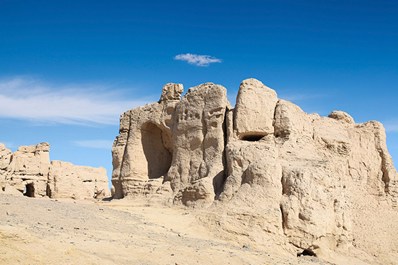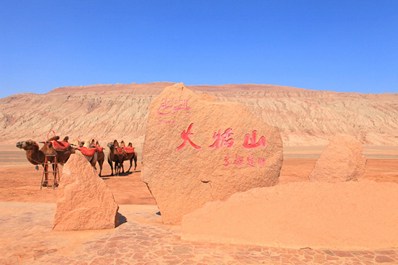Turpan city, China
"Fire Land" of Turfan - the hottest city in China
A green oasis in the middle of the desert, blown by winds from all directions – this was the way how Turpan city appeared before his eyes of weary travelers over a period of two thousand years. It was not only an important commercial and cultural center on the Great Silk Road, but also a strategic post on the ancient caravan route northern branch.
Turpan is a unique city. It is located in the Turpan Basin at the depth of 154 m below sea level. From all sides the city is surrounded by deserts and mountains, destroyed medieval towns and ruins of ancient settlements. The area, the city is situated on, is called the Valley of Winds: the pressure inside the cavity differs much from the pressure outside it, while a rapid movement of air flow generates a strong vortex. This makes a trip through the valley somewhat uncomfortable, though, the local community learned how to adapt to it long ago.
The locals named Turpan as "Fire Land”, because it is the hottest city in China and one of the driest places in the world. In summer the temperature reaches 50°C in the shade, so many excursions to the city’s landmarks and the surrounding area should begin at dawn.
On the way to Turpan, an amazing picture rises to view -thousands of hectares of woodland in the middle of a sandy desert. A freen belt around the city is a kind of buffer between the city and the wilderness. Despite the arid climate, Turpan grows different kinds of fruits: figs, pomegranates, peaches, melons, as well as long-staple cotton and wheat, but perhaps the most common fruit is grapes. In any house, tea houses, and the city’s markets, everywhere, you are sure to see different varieties of grapes, which is favorite sweetmeat for the locals. Not without reason, Turpan is called “Grape Capital” of China.
City owes its prosperity to the ancient kyariz (qanat) irrigation system that the Uyghurs adopted from the ancient Persians. Every year, the melt water from the slopes of the Tien Shan Mountains, flowing down the Turpan valley, is stored by means of a system of underground irrigation canals with a total length of about 5 kilometers, preventing it from evaporation at high temperatures. It should be noted that the Turpan oasis irrigation system ranges among such feats of Chinese engineering art as the Great Wall of China and the Grand Canal.
The city-folk are friendly and hospitable. Despite its climate, Turpan is one of the most densely populated cities in Xinjiang. It is home to about 250,000 people. The major part of the population (70%) is the Muslim Uyghurs. Many of the families are involved in wine production or activity associated with the grape business. The city’s daily life differs much from that of the other cities in Xinjiang. Because of the heat, the city has some kind of siesta in the afternoon, and towards the evening it has the active life started.
Since Turpan is mainly a Muslim city, there are a lot of mosques, both medieval and modern ones. It is prohibited to come in shorts to the mosques, while women should cover their heads.
Among the city’s attractions special prominence should be given to the Emin minaret and mosque, built in the XVIII century by order of the city’s governor Emin Khoja. The Emin mosque with a minaret is one of the most beautiful examples of the Uyghur architecture. The complex is located two kilometers away from the city, so hiring an arbakesh (cart man) will be the right way to get there. Also at the approaches to the city you will find the ancient settlements of Gaochang and Jiaohe, which existed during the period of the Great Silk Road operation and managed to survive up to date. Tourists from all over the world come to Gaochang, to see for themselves one of the world’s largest and best-preserved "dead towns".





